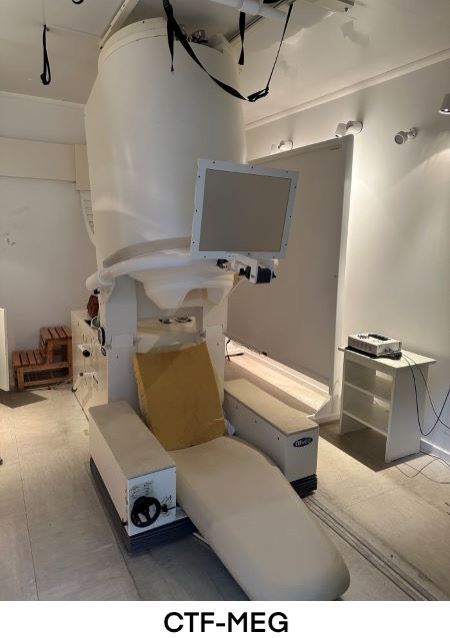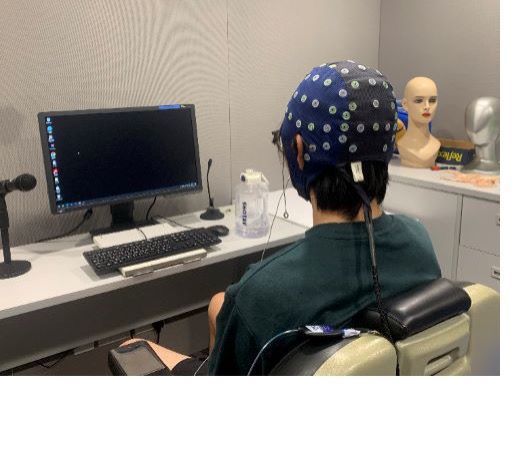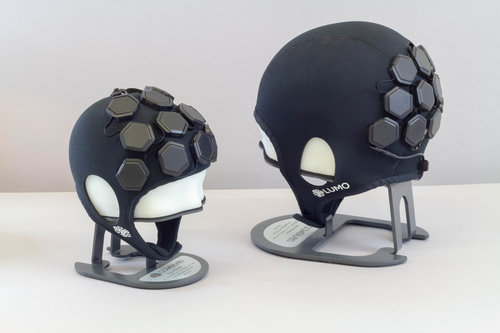Magnetoencephalography (MEG)
 Magnetoencephalography (MEG) is a non-invasive neuroimaging technique that measures the magnetic fields generated by neuronal activity in the brain. By detecting and analyzing these magnetic fields, MEG provides valuable insights into the timing and location of brain activity with high temporal resolution. This enables us to study various cognitive processes, such as perception, language, and memory, and investigate the underlying neural mechanisms. MEG holds promise for advancing our understanding of the human brain and has potential applications in diagnosing and treating neurological disorders.
Magnetoencephalography (MEG) is a non-invasive neuroimaging technique that measures the magnetic fields generated by neuronal activity in the brain. By detecting and analyzing these magnetic fields, MEG provides valuable insights into the timing and location of brain activity with high temporal resolution. This enables us to study various cognitive processes, such as perception, language, and memory, and investigate the underlying neural mechanisms. MEG holds promise for advancing our understanding of the human brain and has potential applications in diagnosing and treating neurological disorders.
Teng, X., Ma, M., Yang, J., Blohm, S., Cai, Q., & Tian, X. (2020). Constrained Structure of Ancient Chinese Poetry Facilitates Speech Content Grouping. Current Biology
Teng, X., & Poeppel, D. (2019). Theta and Gamma Bands Encode Acoustic Dynamics over Wide-ranging Timescales. Cerebral Cortex.
Teng, X., Tian, X., Doelling, K., & Poeppel, D. (2018). Theta band oscillations reflect more than entrainment: behavioral and neural evidence demonstrates an active chunking process. European Journal of Neuroscience.
Teng, X., Tian, X., Rowland, J., & Poeppel, D. (2017). Concurrent temporal channels for auditory processing: Oscillatory neural entrainment reveals segregation of function at different scales. PLoS biology.
Electroencephalogram (EEG)
 Electroencephalogram (EEG) is a non-invasive neurophysiological technique that records the electrical activity of the brain. It uses electrodes placed on the scalp to measure and analyze the fluctuations in brain waves, providing valuable information about brain function and activity patterns. EEG is widely used in both clinical and research settings to study various aspects of cognition, sleep, and neurological disorders. Its high temporal resolution allows for the examination of rapid changes in brain activity, offering insights into brain dynamics and aiding in the diagnosis and treatment of conditions such as epilepsy and sleep disorders.
Electroencephalogram (EEG) is a non-invasive neurophysiological technique that records the electrical activity of the brain. It uses electrodes placed on the scalp to measure and analyze the fluctuations in brain waves, providing valuable information about brain function and activity patterns. EEG is widely used in both clinical and research settings to study various aspects of cognition, sleep, and neurological disorders. Its high temporal resolution allows for the examination of rapid changes in brain activity, offering insights into brain dynamics and aiding in the diagnosis and treatment of conditions such as epilepsy and sleep disorders.
Teng, X., & Zhang, R-Y. (2021) Sequential Temporal Anticipation Characterized by Neural Power Modulation and in Recurrent Neural Network. bioRxiv.
Teng, X., Larrouy-Maestri, P., Poeppel, D. Segmenting and Predicting Musical Phrase Structure Exploits Neural Gain Modulation and Phase Precession. bioRxiv
Functional near-infrared spectroscopy (fNIRS)
 Functional near-infrared spectroscopy (fNIRS) is a non-invasive neuroimaging technique that measures changes in hemoglobin concentration to assess brain activity. It utilizes near-infrared light to penetrate the scalp and skull, enabling the detection of oxygenated and deoxygenated hemoglobin levels in the brain's cortical regions. By monitoring these hemodynamic changes, fNIRS provides insights into brain functions associated with cognitive processes, such as attention, memory, and language. With its portability and minimal participant discomfort, fNIRS holds promise for applications in clinical research, brain-computer interfaces, and rehabilitation therapies for neurological disorders.
Functional near-infrared spectroscopy (fNIRS) is a non-invasive neuroimaging technique that measures changes in hemoglobin concentration to assess brain activity. It utilizes near-infrared light to penetrate the scalp and skull, enabling the detection of oxygenated and deoxygenated hemoglobin levels in the brain's cortical regions. By monitoring these hemodynamic changes, fNIRS provides insights into brain functions associated with cognitive processes, such as attention, memory, and language. With its portability and minimal participant discomfort, fNIRS holds promise for applications in clinical research, brain-computer interfaces, and rehabilitation therapies for neurological disorders.
Investigating Neural Responses to Speech Intelligibility in Cantonese context with functional Near-infrared spectroscopy (fNIRs)(lab project)
Behavioral study and Neural Networks
Behavioral studies in psychology investigate human behavior to understand cognitive processes, emotional responses, and social interactions. We observe and analyze behaviors, such as decision-making, attention, and learning, to uncover underlying psychological mechanisms. These studies employ experimental or observational methods, offering valuable insights into human behavior.
Neural networks are computational models inspired by the structure and functioning of the human brain. They consist of interconnected nodes (neurons) that process and transmit information. In psychology and behavioral studies, neural networks are used to simulate and understand complex cognitive processes, such as learning, memory, and decision-making. By mimicking the brain's neural connections, these models provide insights into human behavior and contribute to our understanding of how the mind processes information and generates behavior.
Teng, X., & Zhang, R-Y. (2021) Sequential Temporal Anticipation Characterized by Neural Power Modulation and in Recurrent Neural Network. bioRxiv.
Teng, X., Ma, M., Yang, J., Blohm, S., Cai, Q., & Tian, X. (2020). Constrained Structure of Ancient Chinese Poetry Facilitates Speech Content Grouping. Current Biology
